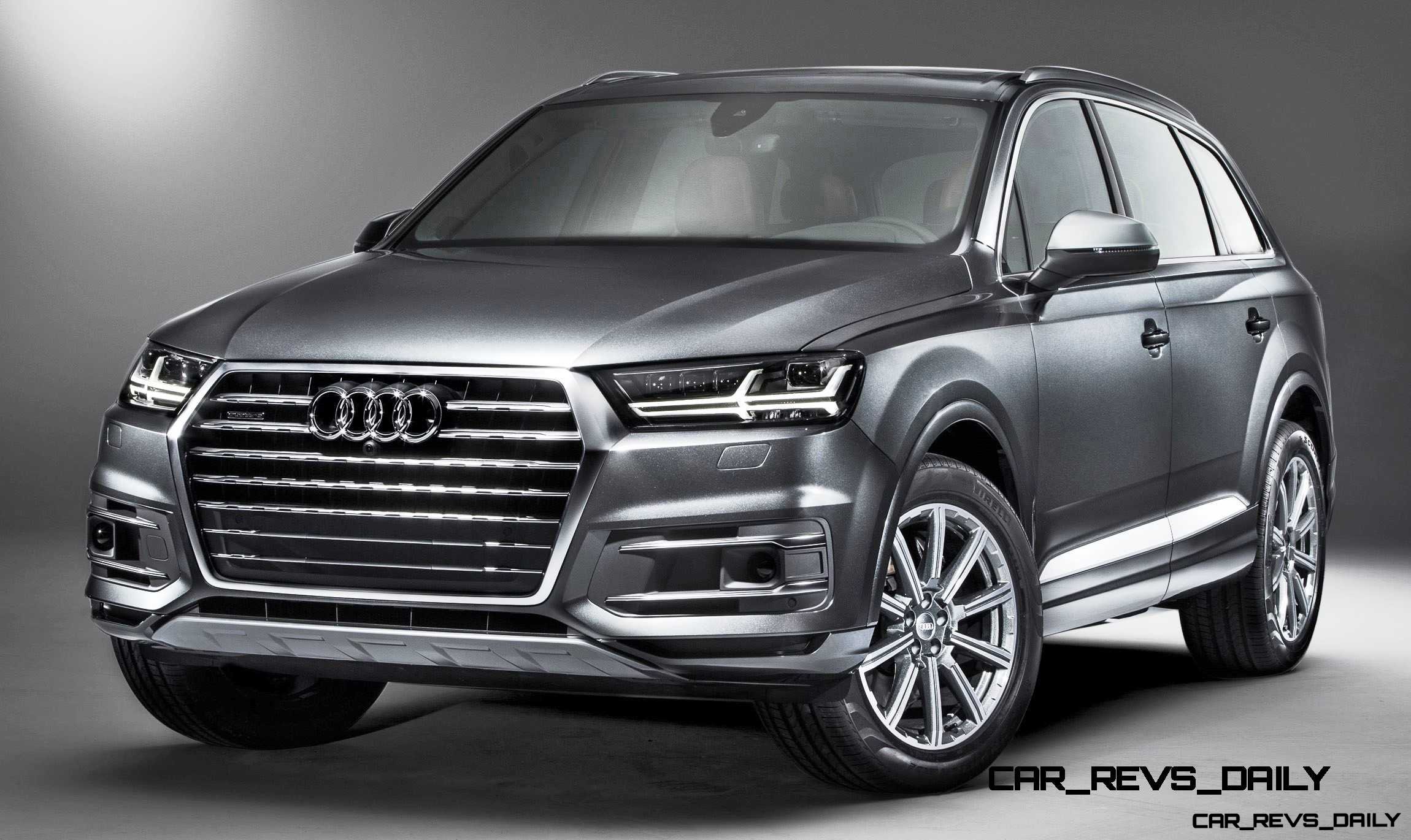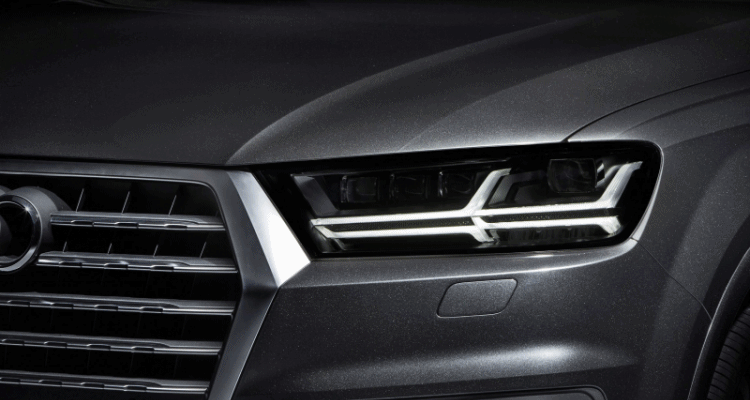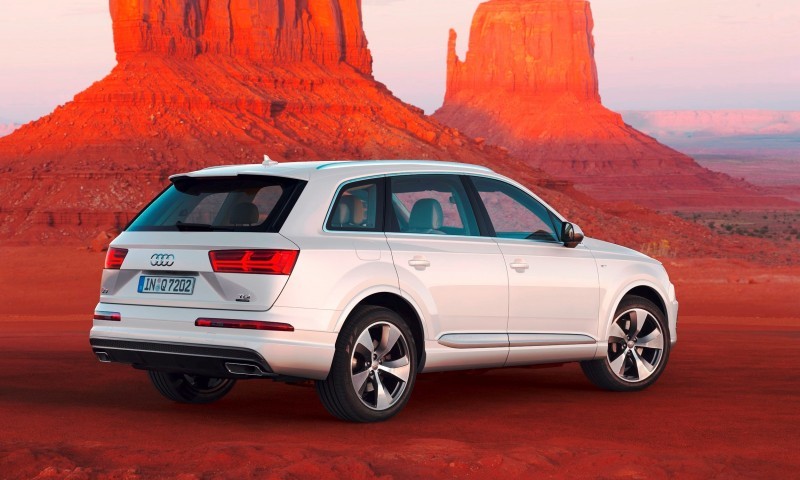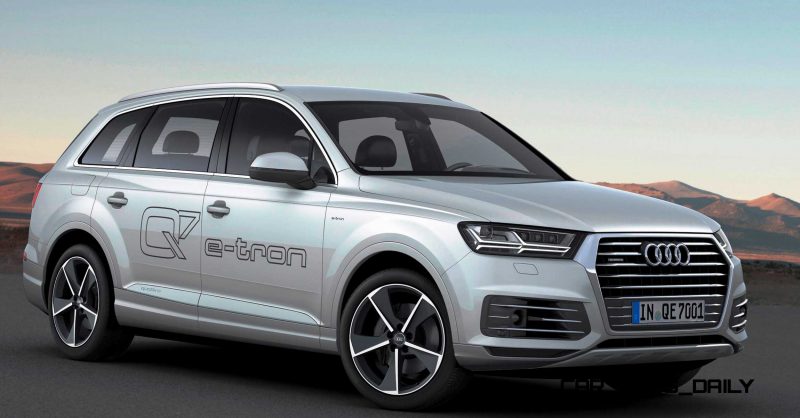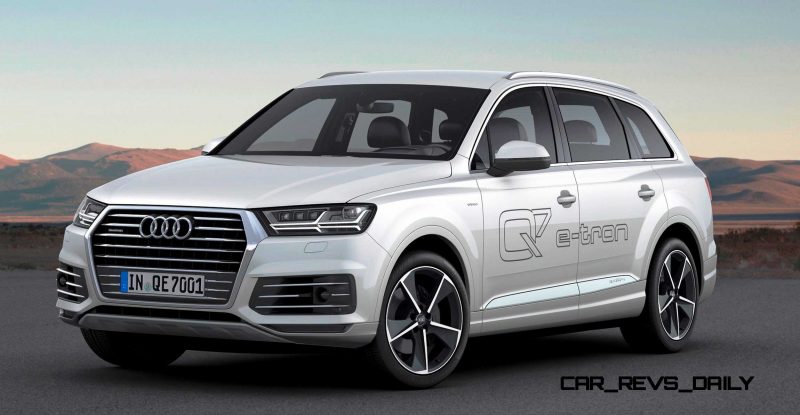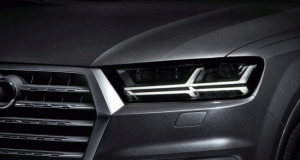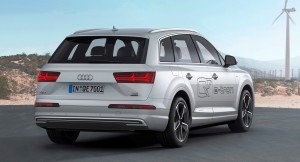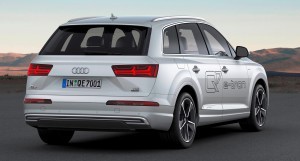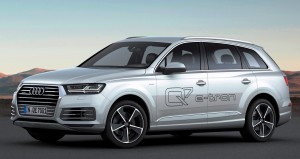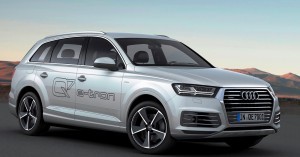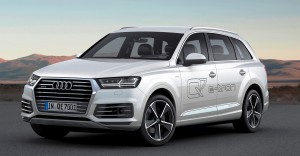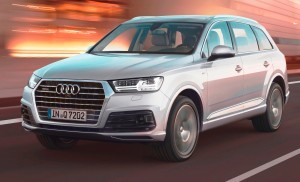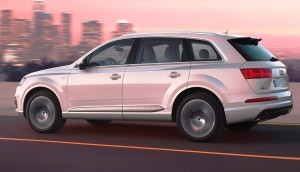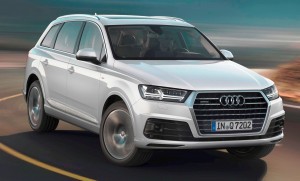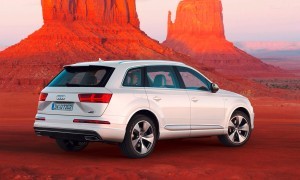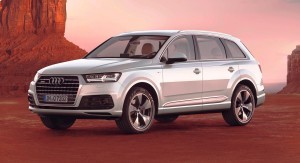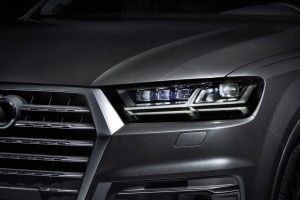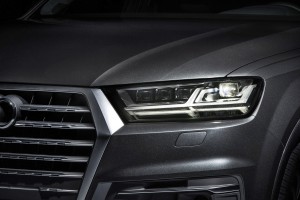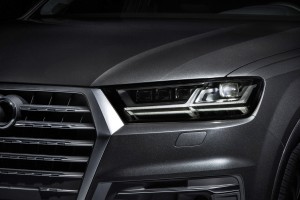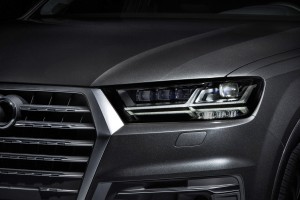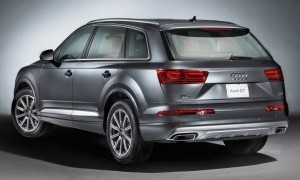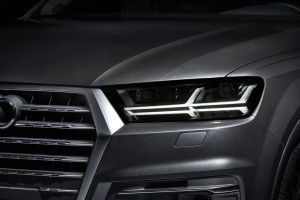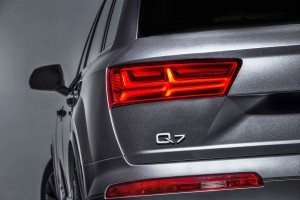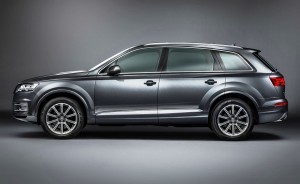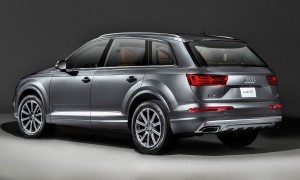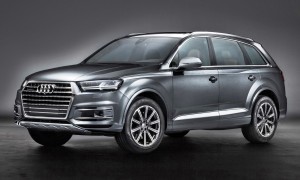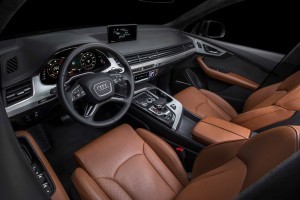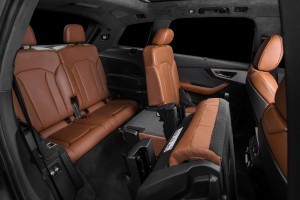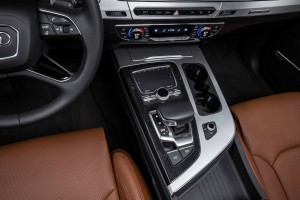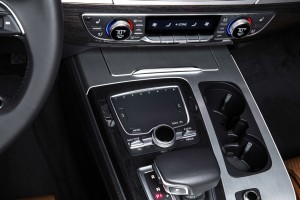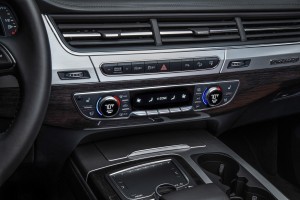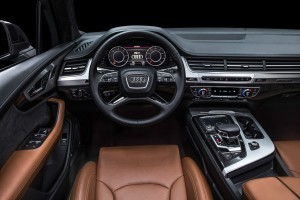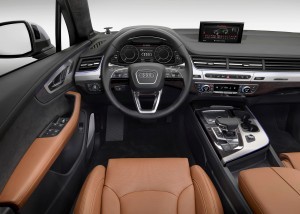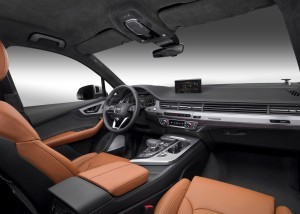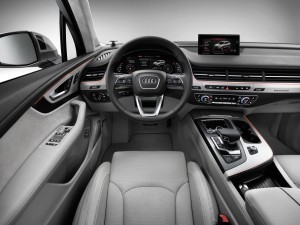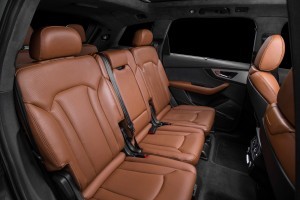As any fan of locomotives or submarines will tell you, the combination of diesel engines and hybrid battery tech is a match made in heaven. Endless research has determined that diesel-electric is the most efficient and powerful combination for heavy machinery.
Typically, in the car business, diesel-electric power has been shunned because the combination is too expensive. Diesels are around a $4000 price premium above a gas engine, while hybrid components can add at least $5000 to a car’s wholesale price to make.
But in a class like the large SUV segment, innovation is affordable if it can achieve huge range, technological leadership and road refinement.
It looks like Audi is actively pursuing submarines and train engines with the new Q7 e-tron TDI quattro. The e-tron portion of the tech is likely a modular piece of the kit, and able to be switched out in favor of a gasoline main engine.
This is most likely in the diesel-averse US market, but the Q7 e-tron TDI quattro is already confirmed likely as a production vehicle in Europe.
We hope Audi brings this ultra-tech-equipped Q7 to the US market. It is too bad about the icky name. I guess eTDI was too simple. ?
Sidebar: Not as simple as these god-awful photochops of the Q7 visiting in Monument Valley — but there is an elegance in not having a name as long as “2016 Audi Q7 e-tron 3.0 TDI quattro.”


— Second sidebar: what is with the tiny shopping-cart wheels and tires on the Q7 e-tron? Yes to Eco. But at what cost!
If so, it looks like a two-horse race for seven-seat supremacy between the new Volvo XC90 T8 and this Q7.
But do not write off the upcoming Mercedes-Benz GLS-Class (replacing GL-Class) and the confirmed BMW X7 xDrive35d with its diesel powerplant….!
2016 Audi Q7 e-tron 3.0 TDI quattro
Press release
Ingolstadt/Geneva, 2015-03-02
Great class, minimal emissions –
the new Audi Q7 e-tron 3.0 TDI quattro
- First diesel plug-in hybrid with quattro drive in its segment
- Best value in the segment: up to 56 kilometers (34.8 mi) electric range
- Maximum efficiency with hybrid management
Audi Q7 e-tron 3.0 TDI quattro
It accelerates from a standstill to 100 km/h (62.1 mph) in six seconds, and yet consumes not even two liters of diesel per 100 kilometers (117.6 US mpg). The Audi Q7 e-tron quattro is sporty, comfortable and at the same time highly efficient. The world’s first TDI plug in hybrid with quattro drive, it is also the first plug-in hybrid with a diesel engine from Audi.
The Q7 e-tron quattro is Audi’s second model with a powerful plug-in hybrid drive system. The model combines the best of two worlds: Powered by the lithium-ion battery, the large SUV covers up to 56 kilometers (34.8 mi) on electric power alone – quietly, powerfully and with zero local emissions. Together with the diesel engine, the car can cover a total distance of 1,410 kilometers (876.1 mi).
Sporty power and minimum consumption
The Audi Q7 e-tron quattro is the world’s first plug-in hybrid car with a six-cylinder diesel engine and permanent all-wheel drive. Its sporty power is impressive: The 3.0 TDI and electric motor deliver 275 kW (373 hp) and 700 Nm (516.3 lb-ft) of system torque – enough to accelerate from 0 to 100 km/h (62.1 mph) in 6.0 seconds and for a top speed of 225 km/h (139.8 mph). The Q7 e-tron quattro travels up to 56 kilometers (34.8 mi) on electric power alone. According to the ECE standard for plug-in hybrid vehicles, the Audi Q7 e-tron quattro needs only 1.7 liters of diesel fuel per 100 kilometers (138.4 US mpg) – with a CO2 emission level of less than 50 grams per kilometer (80.5 g/mi) and a new best value in the segment. The standard thermal management system with integrated heat pump was specially developed for the Q7 e‑tron quattro. With this technology, Audi is the first manufacturer worldwide to set a new benchmark in the areas of interior comfort and climate control efficiency.
Space and comfort: the culture of travel
The Audi Q7 e-tron quattro impresses with luxury-class comfort features and the largest interior in its field of competitors, besides other features. The balanced chassis, optionally available with adaptive air suspension, combines excellent ride comfort and distinctly sporty handling. The Audi Q7* sets standards with the display and operating concept of the standard Audi virtual cockpit and a newly developed MMI system.
The standard MMI navigation plus, with Audi connect internet module, is closely integrated into the hybrid management system on the Audi Q7 e-tron quattro. Using navigation data and real-time traffic information, the most fuel-efficient choice of four modes can be calculated along the route to the destination already when the car is started, even for long distances. The predictive efficiency assistant facilitates a forward-looking hybrid strategy, and is another new and breakthrough technology from Audi. Operation via the MMI touchpad or by means of naturally spoken commands provides the utmost convenience.
The new Audi Q7 e-tron quattro is a long-distance car with great sporting talent and yet suitable for everyday use. The new electromechanical power steering is highly efficient as well as sensitive. The five-link wheel suspension, also newly developed, on the front and rear axles is lighter by more than 60 kilograms (132.3 lb) compared with the axles on the predecessor model, and greatly contribute to the high driving dynamics. The lowered center of gravity also plays an essential role here.
The new Audi Q7 e-tron 3.0 TDI quattro
275 kW (373 hp) system output and 700 Nm (516.3 lb-ft) system torque – the Audi Q7 e-tron quattro sets new standards with its plug-in hybrid technology and quattro drive. The large SUV accelerates like a sports car from 0 to 100 km/h (62.1 mph) in 6.0 seconds, but consumes no more than 1.7 liters of fuel per 100 kilometers (138.4 US mpg) in the NEDC cycle – a best value in its class.
The Audi Q7 e-tron quattro is the first plug-in hybrid car in the world to combine a six‑cylinder diesel engine with quattro drive. With a system output of 275 kW (373 hp) and 700 Nm (516.3 lb-ft) system torque, it accelerates from 0 to 100 km/h (62.1 mph) in just 6.0 seconds, and continues up to a top speed of 225 km/h (139.8 mph). According to the relevant standard for plug-in hybrid vehicles, however, the large SUV needs no more than 1.7 liters (138.4 US mpg) of fuel in the NEDC cycle (with less than 50 g CO2 per km (80.5 g/mi)). This value too sets new standards.
Like all Audi hybrid models, the Q7 e-tron quattro has also been designed as a parallel hybrid. The 3.0 TDI, a highly efficient latest-generation V6 diesel engine, delivers 190 kW (258 hp) of power and 600 Nm (442.5 lb-ft) of torque. Active engine mounts – a world first for a diesel engine – eliminate unwanted vibrations through selective counter pulses.
The disk-shaped electric motor provides 94 kW and 350 Nm (258.1 lb-ft) of torque. Together with a decoupler, it is integrated into the eight-speed tiptronic. The automatic transmission is outstanding for its high efficiency and low weight. The quattro permanent all-wheel drive, also compact and lightweight, transmits power to all four wheels. During fast cornering, its center differential works closely with the wheel-selective torque control system, an intelligent software feature.
56 kilometer (34.8 mi) electric range: best value in the segment
The lithium-ion battery consists of 168 high-quality battery cells and is fluid-cooled. With a capacity of 17.3 kWh, it allows a 56 kilometer (34.8 mi) range in electric mode – another record in the segment. The total range with the TDI engine is 1,410 kilometers (876.1 mi).
Another efficiency component is the standard thermal management system with integrated heat pump, specially developed for the Q7 e-tron quattro. This makes it possible for the waste heat from the electrical drive components to be made available to the interior of the Q7 e-tron quattro. Audi is the first manufacturer worldwide to introduce this technology in series production in a plug-in hybrid and is thus setting new standards in the areas of interior comfort, climate control efficiency and range in EV mode. As well as heating up the interior more quickly, the customer also benefits from a far-reaching electric driving experience.
The new two-phase charging technology installed in the new Q7 e-tron quattro allows charging with up to 7.2 kW of power. Depending on the infrastructure (appropriate high-performance industrial socket) and the charging cable, full charging of the battery takes about two-and-a-half hours. A power charging cable is standard equipment. Audi offers its customers an optional package of e-tron services. They range from changeover to renewably generated electricity (Audi Energy) to installation and customer service. A convenient solution is also provided by the standard e-tron services in the Audi connect portfolio, for controlling functions like charging and air conditioning via smartphone.
Maximum efficiency: hybrid management
The hybrid management system controls the operating states of the Audi Q7 e-tron quattro intelligently, flexibly and with high efficiency. The driver can choose between four modes. The EV mode prioritizes electric driving, while in hybrid mode hybrid management decides on the type of drive for the most part freely. In battery hold mode, the system stores the available electrical energy, and charges the battery in battery charge mode.
The large SUV generally starts in electric mode. To activate the TDI, the driver has to press down on the active accelerator pedal (another innovation from Audi) beyond a certain point of resistance, which depends on the requirements of the hybrid management system. A pressure point must also be overcome for boosting, in which case both the engine and motor work together.
When the hybrid mode is active and the eight-speed tiptronic with integrated electric motor is in shift position D, the Audi Q7 e-tron quattro changes to coasting mode once the driver takes his foot off the accelerator. The TDI and electric motor are then deactivated. Should the Audi Q7 e-tron quattro approach a slower vehicle ahead or a traffic circle or the city limit, the coasting mode ends in favor of controlled regenerative deceleration. To detect the traffic situation ahead, the data from MMI navigation plus, the front camera and (if adaptive cruise control is on board) the radar sensors are used.
When driving in shift position S and in the battery charge mode, energy recovery begins as soon as the driver releases the accelerator. The driver can progressively influence the degree of recuperation by operating the shift paddles on the steering wheel. The majority of all brake applications in everyday use also occur via the electric motor. In the event of moderate or sharper deceleration, the hydraulic brakes come into play.
The standard MMI navigation plus is closely integrated in the hybrid management system in the Audi Q7 e-tron quattro. Based on the navigation data and real-time traffic information, the most fuel-efficient choice of four modes can be calculated along the route to the destination as soon as the car is started, even for long distances. The predictive efficiency assistant facilitates a forward-looking hybrid strategy, and is another new and breakthrough technology from Audi.
During driving, the predictive efficiency assistant supplies highly precise information on the near surroundings – creating a detailed picture of up to three kilometers (1.9 mi) ahead along the route from the navigation and camera data as well as from the radar information. On approaching traffic signs with speed limits, town signs, bends, traffic circles and intersections, the system visually signals to the driver to release the accelerator pedal. At the same time, the active accelerator pulses once against the sole of his or her foot.
New technologies: top comfort and sporty handling
The new Audi Q7 e-tron quattro is a long-distance car with great sporting talent and yet suitable for everyday use. The new electromechanical power steering is highly efficient as well as sensitive. The five-link wheel suspensions, also newly developed, on the front and rear axles are lighter by 60 kilograms (132.3 lb) compared with the predecessor model, and greatly contributes to the high driving dynamics. The lowered center of gravity also plays an essential role here.
Even the basic version of the large SUV rolls along gently and smoothly, while comfort is further enhanced by the optional adaptive air suspension with controlled damping. The driver can regulate the mode of operation via the standard Audi drive select dynamic handling system. It offers up to seven modes and integrates further technical components such as the steering, accelerator and automatic transmission.
As an all-rounder for leisure, family, sports and business, the Audi Q7 e-tron quattro also effortlessly masters easy terrain. A tilt angle display, hill descent control, an off-road mode for the Electronic Stabilization Control (ESC) and off-road navigation are standard.
Power and understatement: the design
The design of the new 5.05 meter-long (16.6 ft) Audi Q7* strikes a balance between powerful, intensified stylistic elements and elegant understatement. Details such as the deeply sculpted Singleframe grille, the striking emphasis of the wheels and the flared edges over the wheels – the “quattro blisters” – embody the brand’s DNA. All lines and surfaces are designed precisely and incisively, and accentuate the width and solidity of the car. The tailgate wraps around the steeply angled D-pillars – typical of the Q models from Audi.
The Singleframe, the air intakes, the 19-inch wheels and the rear diffuser are specially designed on the Q7 e-tron quattro. The headlights are three-dimensional, with their light signature appearing as a double arrow.
The body plays a decisive role in the relatively low weight of the Audi Q7 e-tron quattro. With its many components made of hot-formed steel and aluminum, it utilizes the same lightweight construction potential as the conventional Q7. The drag coefficient is only 0.34.
Elegant design and top quality: the interior
The Audi Q7 e-tron quattro has the most spacious interior in its segment. The three rear seats have adjustable backrests and can be moved fore/aft as desired. The lithium-ion battery is accommodated in a space-saving way: The luggage compartment has a capacity of 890 liters (31.4 cu ft) in its basic configuration, with a maximum of 2,075 liters (73.3 cu ft). An electrically operated tailgate is standard.
Design elements like the wrap-around – the long arc around the driver and front passenger – the trim strips and the panel of air vents emphasize the generosity of the interior. The two-part trim areas allow many individual combinations; the range of upholstery is of luxury-class standard. Numerous materials from the elegant Audi design selection are new to the Q family. The workmanship makes no compromises – typical Audi.
State of the art: operation and displays
A highlight in the Q7 e-tron is the standard Audi virtual cockpit – the fully digital instrument cluster with its 12.3-inch diagonal presents all the important information in fascinating graphics of brilliant quality. The driver can retrieve different levels of information, including specific e-tron displays such as the power meter. The large display makes it possible to switch to a conventional tachometer or to display it simultaneously with the power meter. In addition, the instrument cluster depicts the displays for the energy flow, the range (with numbers and graphs) and the charge level of the battery.
Audi also uses the latest technology from consumer electronics in the area of infotainment. Its main element is the second-generation modular infotainment platform, which utilizes the enormous computing power of the Tegra 30 graphics chip from NVIDIA. Operation is by voice, with the multifunction steering wheel or with the completely newly developed MMI terminal, the MMI touchpad. On request, Audi will integrate the MMI all-in-touch, the touchpad with haptic feedback.
Audi has added specific items to infotainment for displays in electric mode. Consumption statistics are available, for example, along with a graphic display of the electric range in the navigation map. Charging as well as the preliminary air conditioning can also be time-controlled and adapted to the customer’s requirements, such as departure time, so as to save resources and costs.
The standard Audi connect component links the Q7 e-tron quattro to the internet using the fast LTE standard – another unique selling point of the large SUV. Passengers can surf and email with their mobile devices via the Wi-Fi hotspot, while the driver can make use of numerous new online services and apps in the car. The additional elements are also highly attractive – the Audi tablet, which serves as Rear Seat Entertainment, the 3D sound systems from Bose and Bang & Olufsen and the new Audi phone box that inductively charges cell phones.
The equipment: typically top of the line
The Audi Q7 e-tron quattro comes with the standard equipment of a top model. Its special features include the Audi virtual cockpit, MMI navigation plus, predictive efficiency assistant and 19-inch wheels. The automatic air conditioning is also a tailored solution. It operates in unison with a heat pump that utilizes the waste heat of the electrical drive components for the thermal management. As an important efficiency element, it is another great innovation in the Audi Q7 e-tron quattro, heating up the interior faster at low temperatures, for example, to extend the electric range by up to 20 percent.
The options for the large SUV include a head-up display, tinted privacy glazing and a panoramic glass sunroof. If desired, the driver and front passenger can sit on climate-controlled customized contour seats with massage function.
The new Audi Q7 e-tron quattro also sets standards in assistance systems. New, for example, are collision avoidance assist, turn assist, cross-traffic assist and trailer assist. The adaptive cruise control including traffic jam assist takes over the steering from the driver on well-paved roads at speeds of up to 65 km/h (40.4 mph) if the traffic is slow-moving. In combination with the predictive efficiency assistant, speed is automatically adjusted when entering built-up areas and to observe speed limits as well as on bends and at intersections, once again using the coasting mode.
The Audi Q7 e-tron quattro will arrive at dealers in Germany in the spring of 2016.
Fuel consumption of the models named above:
Audi Q7:
Combined fuel consumption in l/100 km: 8.3 – 5.7 (28.3 – 41.3 US mpg)**;
Combined CO2 emissions in g/km: 193 – 149 (310.6 – 239.8 g/mi)**
**The fuel consumption and the CO2 emissions of a vehicle vary due to the choice of wheels and tires. They not only depend on the efficient utilization of the fuel by the vehicle, but are also influenced by driving behavior and other non-technical factors.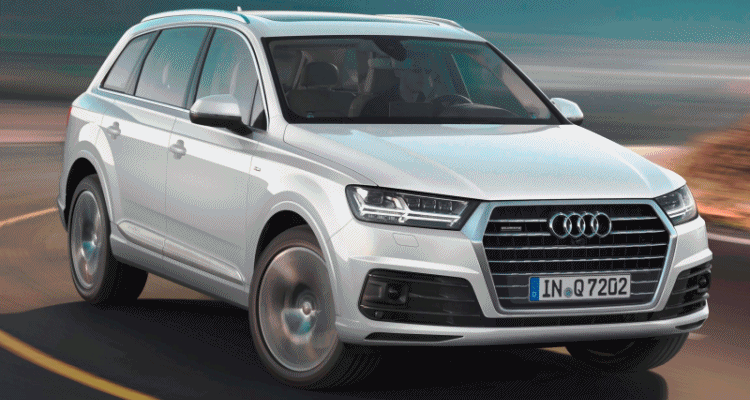

Tom Burkart is the founder and managing editor of Car-Revs-Daily.com, an innovative and rapidly-expanding automotive news magazine.
He holds a Journalism JBA degree from the University of Wisconsin – Madison. Tom currently resides in Charleston, South Carolina with his two amazing dogs, Drake and Tank.
Mr. Burkart is available for all questions and concerns by email Tom(at)car-revs-daily.com.

